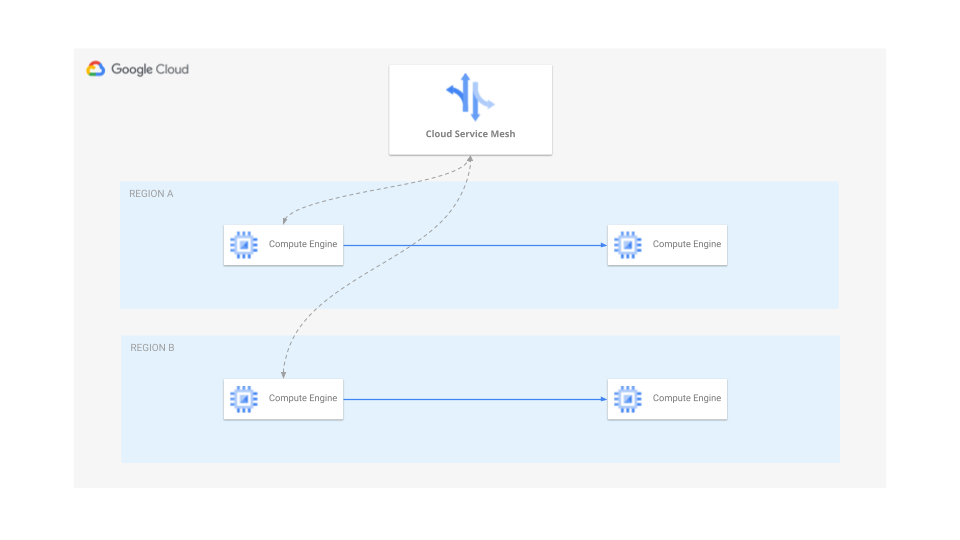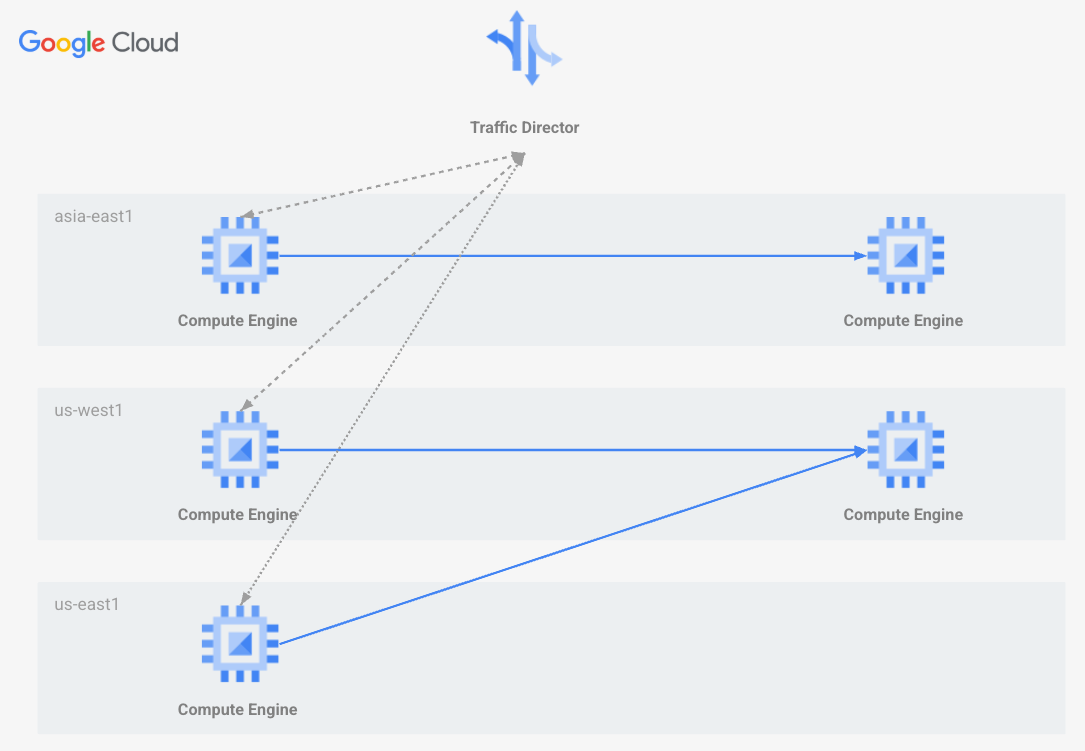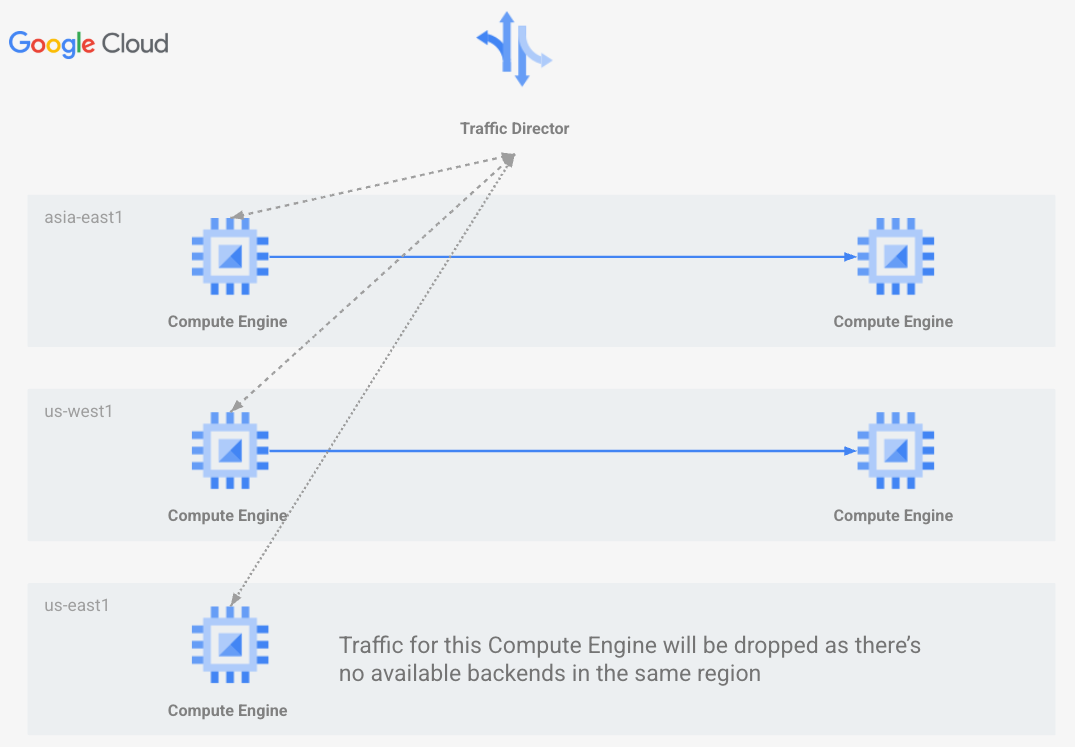Isolation for Cloud Service Mesh
This page shows you how to configure your service mesh with better request isolation for your backend service by creating an isolation config.
This feature provides additional isolation support for the backends of your services to prevent cross-region overflow.
By default, Cloud Service Mesh uses the waterfall by region algorithm to decide where your user traffic should be routed to. With this algorithm, Cloud Service Mesh routes traffic to the closest region until the backends are running at their configured capacity limit. After that, traffic will start to overflow into a region that is further away.
With this feature, based on your frontend region and configuration of isolation, traffic is limited to the closest or local region and won't overflow if the closest region is running out of capacity. This help you prevent potential cascading failures and limit potential outages in the same region. You otherwise still manage your service config at the global level.

Whether or not to use this feature depends on your actual use cases and you should carefully explore the following considerations before using it:
- If your backends in a region are overloaded, Cloud Service Mesh may still send additional traffic to them even if backends in other regions can handle the traffic. This means each individual region is more likely to overload due to additional traffic and you need to plan accordingly.
- Your traffic is still routed with a global control plane. This means there is still a chance of globally coordinated failures across multiple regions.
- This feature is configured with the serviceLbPolicy resource. All restrictions still apply.
- With the STRICT isolation mode, requests fail if there are no serving backends in the same region.
There are two scenarios after applying this feature:
Nearest Isolation
Nearest Regional Isolation is where a frontend with collocated backends will be isolated to only that region. If no backend available is in the local location, it will be connected to the backend region while optimizing network latency.

Strict Isolation
Strict Regional Isolation is where frontend locations can only reach backends within the local region. Frontends without serving backends in the local region will drop all their traffic.

Enabling isolation
gcloud
Perform the following steps to create an isolation config using Google Cloud CLI.
Run the following command to create a
serviceLbPolicy:gcloud network-services service-lb-policies create my-isolation-policy \ --isolation-config-granularity=REGION \ --isolation-config-mode=ISOLATION_MODE \ --location=globalReplace ISOLATION_MODE with one of the following options:
- NEAREST: Traffic is sent to the nearest region.
- STRICT: Traffic fails if no serving backends are available in the same region as the frontend.
If not explicitly provided, NEAREST is the default value. Note that you can only specify this field if the
--isolation-granularityflag is also set.Alternatively, if you have an existing policy, update it with the following command:
gcloud network-services service-lb-policies update POLICY_NAME \ --isolation-config-granularity=REGION \ --isolation-config-mode=ISOLATION_MODE \ --location=globalReplace POLICY_NAME with the name of your existing policy.
Once a
serviceLbPolicyresource is created or updated, attach it to yourbackendServiceresource:gcloud compute backend-services update BACKEND_SERVICE_NAME \ ‐‐service-lb-policy POLICY_URLReplace BACKEND_SERVICE_NAME with the name of your Backend Service.
Disable isolation
To disable this feature, you have two options:
- Set the
isolationConfigsto unspecified. - Remove
ServiceLbPolicyfrom the service if it is the only feature you enabled with this policy
Set isolationConfigs to unspecified
Run the following command to set the isolationConfigs to unspecified:
gcloud network-services service-lb-policies update my-isolation-policy \
--isolation-config-granularity=unspecified \
--isolation-config-mode=unspecified \
--location=global
Remove ServiceLbPolicy from the service
Run the following command to remove the ServiceLbPolicy:
gcloud network-services service-lb-policies delete my-isolation-policy --location=global
Supportability, Diagnosis, and Troubleshooting
This section describes potential issues after turning on this feature.
Backends overloaded
This feature provides isolation support, and thus traffic won't be shifted to a remote region if the local region is full. So some of your backends could be overloaded if this feature is turned on. If this is not the behavior you are looking for, consider turning off this feature. You can also consider enabling autoscaling to handle backend overloads better.
Traffic was shifted
This feature prevents capacity based traffic overflow. So if your backends were overloaded before turning this feature on, traffic may already have been shifted to a remote region. In that case, turning this feature on could cause these traffic to be shifted back.
Traffic was not shifted
This feature prevents capacity based traffic overflow. So if your backends were not overloaded before turning this feature on, it is likely that the closest region is capable of handling all the traffic. In that case, turning this feature on may not cause traffic shifts in the short term.
Traffic was shifted after backends are added to or removed from a region
When this feature is turned on, traffic may be shifted if new backends are added to a region. This is expected as Cloud Service Mesh will try to route traffic to these backends to optimize the overall network latency. Similarly when the last backends are removed, Cloud Service Mesh will start sending traffic to a remote region. This is also an expected behavior.
Requests failed
If STRICT isolation mode is enabled and there are no backends serving in the same region as the frontend, traffic is expected to fail. If it is not your intended behavior, make sure you have backends in each of the regions where you expect traffic to be sent.
